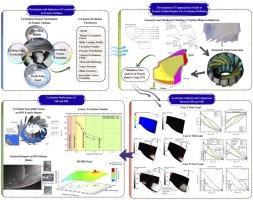Cavitation control in Francis turbines by design optimization across variable operating conditions
引用次数: 0
Abstract
Cavitation is a critical challenge which significantly affects performance of hydro turbines leading to inefficient operation. Cavitation primarily arises due to improper design and frequent variations in operating conditions. Prediction or maintaining cavitation within controlled limits is crucial and challenging task in turbines yet it is essential for employing effective mitigation strategies to ensure the efficient and reliable operation of turbines. In this study, computational fluid dynamics (CFD) analysis of Francis turbine runner employed at DulHasti Power Station (DPS) was conducted using Ansys CFX for 3 different loading conditions (Underload, Full load and Over load) to identify and mitigate cavitation prone areas. Blade loading profiles were analysed to detect the sudden pressure drops responsible for manifesting cavitation and Elliptic Ratio, the key blade design parameter was optimized to control sudden pressure drops and enhance cavitation resistance of runner. The effectiveness of the modified design was validated using Thoma’s cavitation number to ensure improved resistance against cavitation. Our study concluded that the modified runner exhibited reduced cavitation intensity demonstrating the potential for improved operational reliability. This novel framework, optimizing the elliptic ratio of blade to mitigate cavitation, establishes a benchmark for cavitation control in Francis turbine and can be extended to other reaction turbines as well.

混流式水轮机变工况汽蚀控制的优化设计
空化是影响水轮机性能的一个重要问题,它会导致水轮机的低效率运行。空化主要是由于设计不当和操作条件的频繁变化引起的。预测或将空化控制在控制范围内是涡轮机的关键和具有挑战性的任务,但它对于采用有效的缓解策略以确保涡轮机的高效和可靠运行至关重要。在本研究中,使用Ansys CFX对DulHasti电站(DPS)的混流式水轮机转轮进行了计算流体动力学(CFD)分析,分析了3种不同的负载条件(欠载、满载和过载),以识别和减轻易发生汽蚀的区域。分析叶片加载型线,检测导致空化的突然压降和椭圆比,优化关键叶片设计参数,控制突然压降,增强转轮抗空化能力。利用Thoma空化数验证了改进设计的有效性,以确保提高抗空化能力。我们的研究得出结论,改进后的流道表现出更低的空化强度,证明了提高运行可靠性的潜力。该框架通过优化叶片椭圆比来缓解空化,为混流式水轮机的空化控制奠定了基准,并可推广到其他反式水轮机。
本文章由计算机程序翻译,如有差异,请以英文原文为准。
求助全文
约1分钟内获得全文
求助全文

 求助内容:
求助内容: 应助结果提醒方式:
应助结果提醒方式:


